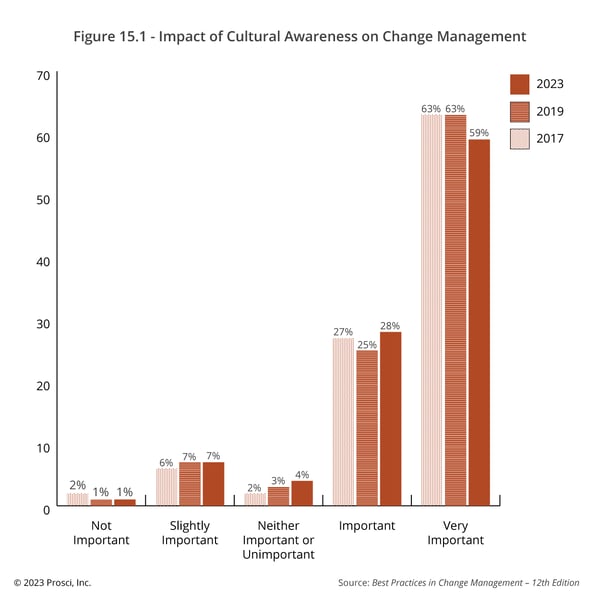Culture and Change Management

4 Mins
Updated: October 17, 2025
Published: March 29, 2023

Culture has a huge impact on our change management projects. Our Best Practices in Change Management research reveals that 88% of participants find cultural awareness to be important or very important to a change management initiative. Being culturally aware enables change practitioners to customize their change management approach, apply culturally specific adaptations while avoiding culturally specific obstacles, and create effective communication plans with the culture of the audience in mind.
Impact of Cultural Awareness on Change
Generally, culture can be found in the behaviors, norms, laws, knowledge, etc. we humans generate and share in society. To many, culture is a broad idea that can be difficult to understand. Through our research, change practitioners and other professionals around the world share insights that can help you better understand culture and its significance in change management practices. 
Culture and Change Management
"Culture is to humans as water is to fish." This popular saying likely emerged from a story from writer David Foster Wallace, describing how the most important and obvious things can be difficult to see and articulate. A fish lives its entire life swimming through water, without knowing what water is. We humans live our lives moving through a culture, which impacts us myriad ways without always making itself known.
Change management is most effective when practitioners acknowledge and understand the cultural context of impacted employee groups and apply that understanding to their approaches. Prosci's Best Practices in Change Management research offers an in-depth look at this topic, offering helpful benchmarks for challenges and adaptations based on cultural considerations.
Our first challenge in working with our own culture and others is to recognize its impact. For example, different cultures view and interact with work relationships differently. Activities and trainings may need to be adapted to culture-specific standards, and communications might need to be customized for different cultural settings.
Anthropologists, intercultural communication professionals, and cultural scholars have been using "cultural dimensions" to study various cultures for years. In doing so, they created a language and framework to help us describe culture. Our research builds on the works of Hofstede, Trompenaars, Hampden-Turner and others, and works such as the 1980 Culture and Consequences, 2004 Globe Study, and 1997 Riding the Waves of Culture.
Cultural Dimensions and Change
Cultural dimensions are characteristic spectra that exist in a culture. For example, assertiveness is a dimension that describes the degree to which a person is able and expected to advocate for their personal well-being and goals in their relationships with others.
At one end of the spectrum, organizations with low assertiveness communicate in indirect, subtle ways, often practicing passive, face-saving communication with an expectation that subordinates will loyally follow executives’ leads.
At the other end of the spectrum, communication tends to be assertive to the point of being aggressive or confrontational. Communication is direct, delivered in a blunt, unambiguous manner, and subordinates are expected to take initiative during interactions with executives.
These are extremes, but identifying your location on the spectrum of assertiveness helps to highlight potential challenges and adaptations. In a low-assertiveness culture, for example, feedback may be very unreliable as individuals are likely to shy away from difficult, honest messages out of fear of upsetting recipients. This ambiguous communication then forces others to make educated guesses rather than base their adjustments and customizations on accurate feedback. Knowing these challenges in this specific cultural setting, you can take steps to encourage honest, direct feedback that provides important information.
In high-assertiveness cultures, we might see extreme resistance expressed vocally. Individuals who dislike the change initiative might bluntly refuse to adopt the changes and actively encourage others to do the same. Too much feedback may also slow project execution. If you can predict this strong response, you can identify potential sources of resistant behaviors and plan for resistance prevention. Clearly, understanding your position on the cultural assertiveness spectrum is helpful.
Of course, these examples don't represent how every individual in a culture behaves. But they do demonstrate a culture’s expectations and beliefs.
Think of these cultural dimensions as lenses that reveal the inner workings of a culture—information we can then use to enhance and improve the effectiveness of our change management efforts.
Culture and Change Management Work
Prosci's Best Practices in Change Management research identifies the cultural dimensions that have the largest impact on change management:
- Assertiveness
- Individualism versus collectivism
- Emotional expressiveness
- Power distance
- Performance orientation
- Uncertainty avoidance
We asked participants to place their organization's culture on each cultural spectra (from extremely low to extremely high). Then we asked them what specific challenges they faced in their change management work due to that placement on each cultural dimension. And finally, we asked what adaptations they would make to address the challenges. You can find this data in our Best Practices research, where we list data and scores by region and industry.
To explain how understanding your specific culture can help your change management work, let's explore power distance, or the extent to which people with lower levels of authority accept the unequal distribution of authority in an organization.
In low power-distance cultures, there is little formal structure or hierarchical separation. Employees have access to higher-level members, expect that all voices will be heard, and expect that company-wide decisions will be made democratically. In this cultural setting, participants identified the challenges they faced and the adaptations they made:
Challenges
- Extensive access meant communication messages often skipped levels within the organization, causing messages to be repeated multiple times
- Individuals from all levels of the organization felt free to challenge and question the change project
- The increased time required to gain commitment and support led to a decrease in productivity
Adaptations
- Increased the number of meetings, engagement activities and functions designed to ensure alignment with the project
- Created structured communication channels to customize messages and allow for employee feedback
- Placed stakeholders in key positions, established communication guidelines, and clearly defined roles to enhance the overall change management plan

3 Ways to Put Cultural Insights Into Practice
Although gaining insight is a great first step, the real value comes from applying your understanding of culture to achieve positive results in change initiatives. Here’s how to use the research to enhance your work.
1. Understand the landscape you're working in
Consider where the impacted individuals fall on each of the six spectra. If you are managing a change that will impact individuals in different cultures, take time to understand and appreciate each of the cultures that will be impacted, how they differ from one another, and how you can alter your approach for each audience.
2. Evaluate your cultural lens
Understand where your home culture sits on the cultural spectra and how your personal paradigm may differ from the culture in which you are managing change. This will help you to better understand how you can interact with and work with other cultures. We don't want to leave our individual cultures behind, but as global change professionals, we must understand how that lens impacts our work.
3. Adapt your approach
If we do not adapt our approach and take culture into account, we can find ourselves trying to hammer a square peg into a round hole. Find the most culturally relevant ways to communicate about the change, and then implement the activities that will have the greatest impact with your audience.
Culture and the People Side of Change
Remember, culture is to humans as water is to fish. It is critically important to keep this in mind when our work centers on helping people change. When we begin to understand culture in a meaningful, tangible way, we have a choice. Do we want to remain blind to the cultural forces at work in the organizations we’re trying to impact? Or do we want to harness those forces to improve our change work, our results, and the experiences of those around us?





